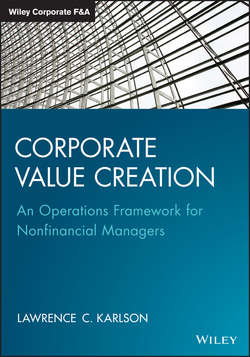Читать книгу Corporate Value Creation - Karlson Lawrence C. - Страница 18
На сайте Литреса книга снята с продажи.
CHAPTER TWO
The Envelope Equations 28
⧉ ROCE and NiROCE
ОглавлениеIn Chapter 1, the Return on Capital Employed (ROCE) was defined as:
[1-29]
Since the objective of the Envelope Equations is to make quick estimates of Net Income and Cash Flow, the classical definition of ROCE needs to be modified because it deals with EBIT, and to get to Net Income involves introducing additional complexity that isn't warranted given the objective of making quick estimates of NI and CFaIA. To get around this, the definition of ROCE in this chapter is modified to use Net Income in place of NOPAT (Net Operating Profit after Tax) and as a result, the term “Net Income Return on Capital Employed (NiROCE)” is introduced and defined as:
[2-1]
At this point it may be worthwhile to comment on why ROCE uses NOPAT. The reason is: It excludes the impact of interest income or expense and since the cause of interest is the debt on the balance sheet (and it is already included in the denominator as part of Interest Bearing Debt), using NI would, in a sense, be double counting because it understates the NOPAT by an amount equal to the after-tax impact of interest. To the extent there is any interest expense, NiROCE would be less than ROCE, and vice versa. If there isn't any interest, the NiROCE and ROCE would be the same.
Underlying Assumptions
In their simplest form, the Envelope Equations are centered around the notion that Net Income and Cash Flow are driven by investments in property, plant, equipment, software, and the like and do not reflect the results of other operational improvements. The assumptions that are important to understand are:
• The underlying assets that generated Year 1's Net Income will continue to do so for the estimating horizon and beyond.
• Investments made during Year 1 don't provide an immediate return but take time, and the incremental Net Income from these investments is generated in Year 2.
• Year 2's Net Income is the sum of the repeating Year 1's Net Income and the Incremental Net Income generated by the investments made in Year 1.
• Like Year 1's Net Income, the investments that generated Year 2's Incremental Net Income will also produce a stream of equal Net Incomes during the subsequent years.
Applying the Equations
Since using the Envelope Equations involves a series of steps, it may be helpful to start the discussion with the end in mind and define the process involved in using the equations before defining the variables and developing the key relationships. Hopefully, by doing so the reader will have an appreciation of where all of this is headed.
As stated earlier, the Envelope Equations provide a way of making rapid estimates of Net Income and Cash Flow. They are built around the concepts of Net Investments (NetInvest), Investment Rate (IR), and Net Income Return on Capital Employed (NiROCE).30 To use the equations, it's necessary to have (or make) estimates for the IR and NiROCE, assume some initial level of Net Income, and then sequentially apply the appropriate equation to calculate the Net Incomes and Cash Flows for the years in question. The way it works is as follows:
• Establish the Investment Rate (IR) and Net Income Return on Capital Employed (NiROCE) that are to be used.
• Start with or make an estimate of the Current Year's (Year 1) Net Income:
Net Income in Year 1 = NI1
• Using the Investment Rate calculate the Net Investment (NetInvest) during Year 1:
NetInvest 1 = (NI1)(IR1)
• With this information, estimate the Cash Flow for Year 1:
CFaIA 1 = NI1 − NetInvest1 ± NetInt1 ± ΔWC1
• Using the NiROCE the company expects from the Net Investment made during Year 1 (the return on the investment is expected to take place the following year), calculate the incremental Net Income (ΔNI2) for the following year (Year 2):
ΔNI2 = (NetInvest1)(NiROCE2)
• The Net Income for Year 2 is the sum of NI1 and ΔNI2.
NI 2 = NI1 + (NetInvest1)(NiROCE2)
• With this information, estimate the Cash Flow for Year 2:
CFaIA 2 = NI2 − NetInvest2 ± NetInt2 ± ΔWC2
• Repeating the procedure provides estimates of subsequent years' Net Incomes and Cash Flows.31
At this point the reader shouldn't be troubled by the fact that the relationships given in the above procedure are not understood. In fact it would be surprising if this wasn't the case. All of the above relationships are a subset of the Envelope Equations. To give the reader some idea of what the complete set looks like and what will be developed in subsequent sections of this chapter and Appendix D, the complete set is shown here.
[2-8]NetInvestn = (NIn)(IRn)
[2-12]NI(n + 1) = NIn + Netinvestn (NiROCE(n + 1))
[2-14]NI(n + 1) = (NIn)[1 + (IRn)(NiROCE(n + 1)]
[2-16]CFaIAn = NIn − NetInvestn ± NetInt ± ΔWC
[2-18]CFaIAn = (NIn)(1 − IRn) ± NetIntn ± WCn
[2-40]
[2-43]NIgn = (IR(n − 1))(NiROCEn)
With the assumptions defined and the application process illustrated, it is now time to develop the Envelope Equations. This process begins with a discussion of Net Investments.
30
The basics of ROCE were covered in Chapter 1.
31
Later, expressions for Net Income and Cash Flow after Investing Activities will be developed in terms of the Investment Rate and Net Income Return on Capital Employed.
